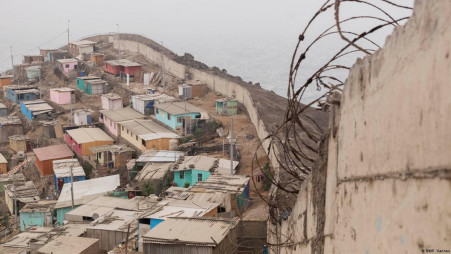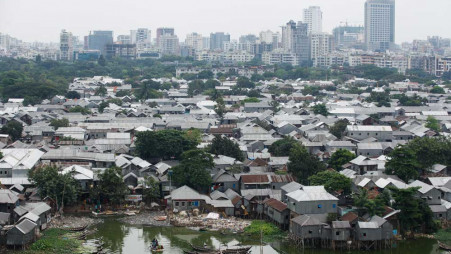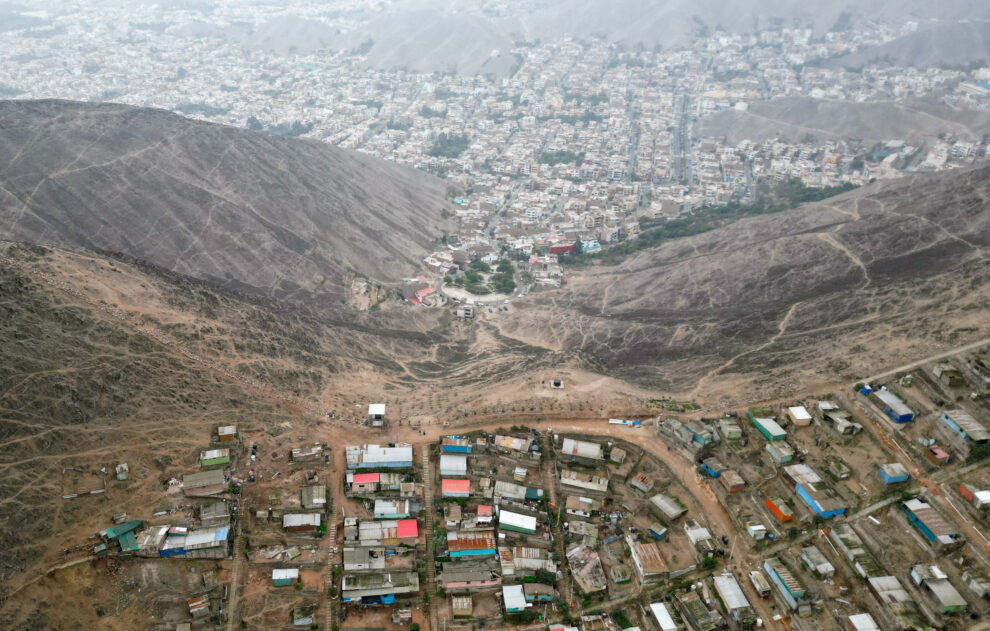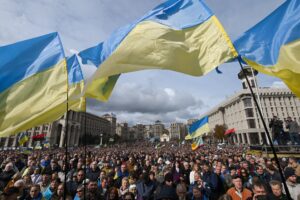This division is perhaps clearest in Lima, the capital of Peru, where stood the Wall of Shame. Although the wall was prepared for demolition on 1 September, its history cannot be erased overnight.

The so-called Wall of Shame which used to separate the neighbourhoods housing the wealthy and the less fortunate in Lima, Peru. The wall was tore down on 1 September. Photo: DW
The line between the rich and the poor is one that traverses the whole world.
There is no nation that does not bear some division between those who live paycheque to paycheque and those whose only concern is how to further increase their wealth and maintain their comfortable lives.
In some countries these divisions are invisible, but felt all the same. In others, there are literal walls built without an ounce of shame or compassion.
In the US, the idiom “living on the wrong side of the tracks” has long been used to describe those who lived in the “bad” part of town.
The poor and the downtrodden – casually labelled criminals as a uniform term – are often all placed under a single umbrella, with no thought that separating them from opportunity would force them to become the very thing the rich declared them to be.
This division is perhaps clearest in Lima, the capital of Peru, where stood the Wall of Shame.
Although the wall was prepared for demolition on 1 September, its history cannot be erased overnight.
Built in 1985, the 10ft high concrete barrier is topped with barbed wire and runs six miles across the capital city of Lima, forming a stark separation from the haves and the have nots.
Ostensibly, the wall was built to protect the wealthy communities of La Molina and Santiago de Surco from the growing number of rural migrants seeking safety from Maoist Shining path guerrillas.
These immigrants would build shanty towns, later known as Pamplona Alta, without access to electricity or water, on the barren hillsides, and then walk down the hill to the wealthy homes to seek work as cleaners, gardeners and labourers.
Eventually that changed.
The wall began to be erected by an elite Jesuit academy to provide security. It was not long before all of the wealthy communities joined in, culminating in a week-long building spree involving cement trucks and police presence that cut off the poor from any chance of making a living.
Now required to either walk two hours to get around the wall to their previous jobs, or pay half a day of wages to take buses, the state of the immigrant community predictably fell to slum status, with rising criminality due to lack of any other options.
And thus the elite pointed at the wall and claimed it was to protect them from the criminals they themselves had a key role in creating.
This is no uncommon situation.
Here in Bangladesh similar stories play out – the separation between classes emphasised by structures, accessibility and even the treatment meted out.
The Korail slum in the capital’s posh Gulshan area, provides the perfect juxtaposition of poverty and progress; it’s a telling picture of those left behind.
A barrier between the two worlds exists, even without the presence of a wall.

A view of the Korail Slum in Dhaka’s Gulshan area. Photo: TBS
In 1961, the land, which now houses the Korail slum, was gripped in an ownership dispute between the Bangladesh Telecommunication Company Limited (BTCL), the Public Works Department (PWD), and other private landowners, leaving the area in legal limbo.
After 30 years, this dispute remains unresolved, leaving local strong men and influential elites from all political parties to unofficially capture sections of the land and rent parcels of it out to the city’s impoverished at low rates.
With development in the surrounding areas increasing, and evictions occurring in other low income areas, the demand for low cost housing rose, and the Korail slums came into being as more and more people moved into the one area they could afford while still staying close to their source of jobs.
Even though as of 2020 over 100,000 residents live in the slum and provide garment, transportation, construction, land development, domestic help, waste management, and small industry labour to the surrounding areas, they are deemed illegal residents and thus receive no utilities regarding water, power, and gas.
Instead these people are serviced by illegal and often risky connections sold to them through syndicates.
While the Korail slum community often suffer injustice as well as poor and dangerous living conditions, they are granted one blessing.
Situated in plain view of Brac Centre, one of Bangladesh’s largest and most celebrated NGO’s, they are often a subject of support from all of Brac’s various poverty programmes, from health, to education, to microfinance.
It is a stark but equally sad contrast, where in Peru the division is obvious and physical, in Bangladesh the division is more societal and often more abusive.
While many NGOs put forth a lot of effort into lifting people from poverty, the majority are still taken advantage of, paying straight into the pockets of the wealthy for the privilege of living in a slum.
Where one travels through Gulshan in fancy cars, residents of Korail often have to opt for a boat to and from their homes, as it is the cheapest form of transport.
There is one key difference here though: the “poor” aren’t hidden from view. And they can’t be either.
Which was not the case in India, as seen in the recent G20 summit.
In the days leading up to the conference thousands of underprivileged were moved from their ramshackle huts beneath flyovers and bridges to shelters built on the outskirts of the city.
An extensive shutdown of the entirety of Delhi for three days during the conference was initiated, preventing all businesses, schools and markets from operating.
Even food deliveries were denied as all residents were “recommended” to stay home.
This is hardly an issue for those who could treat the shutdown as an enforced holiday, but for those who must work each day to feed themselves and their families each night, this was a cruel and unexpected burden.
At the coolie camp, a slum in Vasant Vihar just a short distance from luxury hotels, walls were put up to hide the impoverished.
Ten days before the G20 event began, wooden scaffolding was put up around the slum and then covered with green cloth with banners of the summit, hiding it away from the view of visiting dignitaries.
This act naturally angered the residents, who scornfully claimed that during elections the politicians would eat with them and say sweet words, but then suddenly the same people they broke bread with had become burdens.
All these efforts were part of the Indian government’s “Beautification Project” ahead of the conference.
While Pamplona Alta, Korail Bosti and the Coolie camp, are separated by vast distances, the stories and tragedies behind them are unfortunately similar.
All three are surrounded by walls built with bricks of poverty, inequality and social injustice.
It’s the same brick that can be seen the world over, the same brick no one has attempted to tear down.
Source : TBS News











